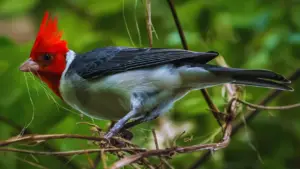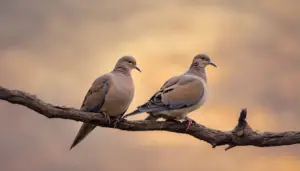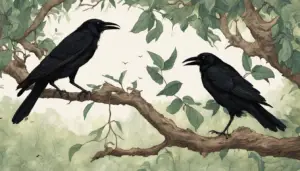Georgia, a state brimming with ecological diversity, is home to an array of enchanting birds, and among them, the majestic owl holds a special place. These mesmerizing creatures of the night can be found across various habitats in the Peach State, presenting a study of beauty, adaptability, and resilience. In this exploration, we delve into the fascinating world of Georgia’s owls, investigating the different species, their chosen habitats, the challenges facing their preservation, and ways for interested citizens to participate in their conservation.
Varieties of Owls in Georgia
Eastern Screech Owl
The Eastern Screech Owl is one of the most common owl species found in Georgia. This small, compact owl has a large head with ear tufts and a yellow-green bill and eyes. Measuring about 6 to 10 inches long, these owls have two distinct color morphs: red and gray, typically varying based on regional and seasonal changes. They have a unique ability to camouflage themselves against tree bark. Known for their eerie, horse-like whistle call, they can be heard in forests, woodlands, suburban parks, and even in city gardens.
Great Horned Owl
Also known as the ‘tiger of the sky,’ the Great Horned Owl is easily identifiable by its prominent, feathery ear tufts that resemble horns. Measuring 18 to 25 inches long, they have large rounded wings, broad tails, and brilliant yellow eyes. Their bodies are covered in a mottled gray-brown plumage with a reddish-brown face. Widely distributed, they inhabit mixed forests, woodlands, swamps, and deserts. Known for their hoots, Great Horned Owls are apex predators with a diet that includes rodents, rabbits, birds, and other small mammals.
Barred Owl
The Barred Owl, also known as the Hoot Owl, is another common owl in Georgia. About 17 to 20 inches long, they have soft grey-brown plumage, wide rounded wings, and dark brown eyes. Their name refers to the bars of color on their chest. These owls favor wet, dense woods and can often be seen around swamps and streams. They are known for their distinctive “Who cooks for you? Who cooks for you-all?” call, which can be heard particularly in the night.
Barn Owl
The Barn Owl is distinctive due to its heart-shaped face and lack of ear tufts. They are medium-sized owls, measuring around 12 to 16 inches long, with pale, buff-colored bodies and dark speckles. They have an eerie, shrill scream that differs from the typical hoots of other owls. True to their name, Barn Owls are often found in barns, church steeples, and tree hollows and have a diet of mostly small rodents.
Short-eared Owl
The Short-eared Owl gets its name from its short feather tufts which resemble ears. Of medium size, measuring 13 to 17 inches long, these owls have broad wings, round heads, and pale faces with vibrant yellow eyes. They are known for their unique flight pattern which consists of buoyant, moth-like wingbeats. Found primarily in open fields and marshes, their primary diet consists of rodents.
The owl species native to Georgia each display their unique behaviors and adaptations, making them a marvel to observe for birdwatchers and nature lovers. Their role enhances Georgia’s biodiversity significantly.

Owl Habitats Across Georgia
Overview of Owl Species in Georgia
Among the avian inhabitants of Georgia, owls play a significant role. The region is recognised for its array of owl species, which include the Great Horned Owl, Barred Owl, Eastern Screech-Owl, and Barn Owl. Additionally, owl species like the Long-eared Owl, Short-eared Owl, Burrowing Owl, and the rare Northern Saw-whet Owl also find their habitat in Georgia.
The Pervasive Presence of Owls in Georgia
Owls are quite adaptable and thus can be found across a variety of landscapes within Georgia. They have been spotted in the Appalachian Mountains in northern Georgia, through to the coastal plains in the southern part of the state. Their habitats range from forests and farmland, to urban areas and suburbs.
Owl Habitats in Forests
Forests provide a natural habitat for many owl species due to the availability of prey and nesting spots. In North Georgia’s dense forests, the Barred Owl and the Eastern Screech-Owl frequent deciduous trees and streams. These owls prefer the densely wooded areas as they offer numerous hiding nooks, providing protection from predators.
Farmland and Open Field Habitats
Unlike their forest-dwelling counterparts, Barn Owls prefer open fields, marshlands, and farmlands. These habitats are typically filled with small mammals and insects that the owls feed on. Barn Owls are often found in and around abandoned barns and silos in rural Georgia, hence their name.
Suburban and Urban Habitats
Surprisingly, both the Great Horned Owl and the Barred Owl have adapted well to suburbia and can be found even in the urban areas. Implemented green spaces, like parks and large tree-laden backyards, provide the necessary conditions for the owls to roost and hunt.
Appalachian Mountains as Habitats
The impressive mountainous regions of Georgia hold a diversity of owl species as well. Great Horned Owls and Barred Owls are sighted regularly, nesting in the hollow spaces and crevices of rocks in the Appalachian Mountains.
The Role of Diet in Habitat Preferences
The diverse diets of different owl species often influence their habitat preference. Great Horned Owls with their diet of larger prey such as rabbits and skunks are more adaptable, hence their wider range of habitats. Conversely, the Short-eared Owls and Northern Saw-whet Owls, who primarily feed on insects and small rodents, are more common in grassland or woodland habitats respectively.
The Impact of Human Activity on Owl Populations
While some owl species have adapted to human-altered landscapes, human activity can negatively impact owl populations. Loss of habitat due to urbanization, pesticide use in farming that can poison prey, and road accidents are factors that can threaten these birds. Conservation strategies, such as the generation of owl-friendly areas, can help to protect owl populations in Georgia.
Climate Change and Owl Habitats
Climate change could potentially affect the distribution of owls in Georgia, as rising temperatures may alter the availability of prey and suitable habitat conditions. The barred owl, for instance, is moving further north in response to climate change, encroaching on the habitats of the endangered spotted owl.
Owls: An Integral Component of Georgia’s Ecosystem
In Georgia’s diverse ecosystem, owls serve as crucial contributors, reinforcing balance and health through their ecological roles. Comprehending their varying habitat preferences is instrumental in the effective monitoring and conservation of these nocturnal creatures. It is even more critical in the face of changing land use patterns and evolving climate conditions, which can heavily impact their habitats and survival.

Issues Impacting Georgia’s Owl Population
Challenges Facing Georgia’s Owl Populations
The growth and sustainability of Georgia’s owl population are hindered by multiple challenges. Notably, the relentless onslaught of urbanization poses a serious threat. The burgeoning urban districts encroach upon their natural habitat, whittling it down to fragmented patches. This increasing anthropogenic footprint culminates in substantial habitat loss, considered to be one of the gravest threats to Georgia’s owl populations. Owls require large, undisturbed woodland expanses for their survival and hunting activities, and such spaces are being steadily eroded due to human infrastructural developments.
The situation is exacerbated by the owls’ limited adaptability to new habitats, unlike some other wildlife species. Dramatic alterations in land structures can render the environment unfit for owls, by reducing the availability of roosting sites, or diminishing the abundance and diversity of prey species.
Climate Change and Owls
Climate change also impinges on Georgia’s owl population in significant ways. Changing climate patterns affect the distribution and abundance of owl prey, further limiting the owl’s dietary resources. Milder winters can lead to an increase in drought-like conditions which adversely affect the forest ecosystem, impacting the owl population as a consequence.
More variable weather conditions, accompanied by a higher incidence of extreme weather events, pose further challenges to owls. For instance, a more significant number of torrential rains can lead to flooding of owl nests situated on the ground, while stronger winds during the breeding season can cause nests in trees to fall, leading to severe injury or death of young hatchlings.
Pesticides
Pesticide use, although not specifically targeted at owls, has indirect harmful effects on the owl population. Pesticides used in agriculture can diminish the population numbers of insects and small mammals, which constitute significant dietary resources for owls. Ingesting prey that has consumed pesticides can also lead to bioaccumulation of toxins in owls.
Conserving Owl Populations in Georgia
Georgia’s owls face severe threats from a variety of fronts, yet there are a number of ongoing conservation efforts aimed at their preservation. One of the main focuses is the introduction of managed forests, which offer a safe haven, with undisturbed habitats where owls can live and feed. These specially controlled areas also mitigate threats from natural predators such as raccoons, that often predate on owl eggs, thus increasing owl survival rates.
An area of increasing importance in conservation strategies is the regulation of pesticide use. Limiting the negative impacts of pesticides on our local ecosystems indirectly works to safeguard the owls’ main food sources.
State wildlife agencies along with local organizations are furthering our understanding of these birds via comprehensive scientific studies. Their research into owl behaviors, habitats, and threats guides conservation initiatives, leading to strategies that are more effective and tailored to specific owl species.
Awareness is also a key component of conservation efforts. Many organizations offer educational programs to enlighten the public about Georgia’s owl species, their important role in our local ecosystems, and the challenges brought on by habitat loss, climate change, among other factors.

Owl Watching and Conservation Opportunities in Georgia
Owl Species Residing in Georgia
Georgia boasts varied ecosystems—from coastal regions to farmlands, forests, and marshes—all of which provide homes to a rich variety of owl species. Familiar species include the Eastern Screech Owl, the Great-Horned Owl, the Barred Owl, the Short-Eared Owl, and the Barn Owl, each with their unique attributes. Population numbers for these species may fluctuate, however, due to factors ranging from changes in habitat availability to fluctuations in food sources.
Owl Watching in Georgia
Owl watching is a popular activity in Georgia that provides unique opportunities for bird watchers and nature lovers to witness these magnificent creatures in their natural habitats. Some of the prime locations for owl watching include the Atlanta Audubon’s Wildlife Sanctuary, the Cochran Mill Park, and the Chattahoochee Nature Center.
Owl watching requires patience and quiet observation. As nocturnal creatures, owls are most active and visible during the early night hours. Try to minimize your disturbance by staying on designated paths and using binoculars or scopes to observe from a distance.
Contribution to Conservation Initiatives
Several conservation initiatives in Georgia encourage public participation to help protect and conserve owl populations. These efforts include habitat restoration, population monitoring, and public education. Organizations like The Georgia Audubon Society offer volunteering opportunities to aid in on-going conservation initiatives.
For example, the Atlanta Audubon’s Wildlife Sanctuary program encourages individuals to create bird-friendly habitats in their yards. These sanctuaries provide essential habitats for local birds, including owls. There’s also the Project Safe Flight Atlanta, aimed at reducing bird-window collisions, a significant cause of bird mortality including owls.
Adopt and Sponsorship Programs
Donations and sponsorship programs provide a crucial source of funding for conservation initiatives. Opportunities to financially support include “adopting” an owl for a period or sponsoring specific conservation programs.
For example, Amicalola Falls State Park & Lodge has in place an adoption program for their live animal exhibit which features several raptors including owls. The funds from the adoption help the park provide quality care for the animals. The Georgia Audubon also lets you sponsor an owl nest box, providing a safe place for owls to breed and raise their young in a protected environment.
Community Science Initiatives
In addition to financial donations, individuals can contribute to owl conservation through participation in community science projects. These are studies carried out by members of the public, often in collaboration with professional scientists. One such initiative is the Atlanta Bird Fest, where people are encouraged to explore and monitor bird populations. Another is Georgia’s Calling Frog Survey, where citizen scientists monitor breeding frog populations—an important indicator of ecosystem health, including owl’s prey availability.
Involvement in such initiatives not only provides valuable data to aid in conservation efforts, but also serves as an opportunity to learn more about owls and their importance within Georgia’s ecological systems. Overall, volunteer-based programs, education, and public engagement are critical for the sustainable conservation of Georgia’s owls.

Against the backdrop of a rapidly changing world, the owls of Georgia, with their haunting hoots and hypnotic gaze, remind us of the untamed magnificence of nature that exists quietly in our own backyard. Knowledge of their species, understanding their habitats, being aware of the threats they face, and the numerous opportunities to contribute towards their preservation, brings us closer to these captivating birds and to nature itself. It is in moments of quiet observation and thoughtful conservation that we, as responsible inhabitants, can ensure their mesmerizing flight continues to grace the Georgian night skies for centuries to come.
Owls in Georgia : FAQs
Q. What species of owls can be found in Georgia?
Georgia is home to several species of owls, including the great horned owl, barred owl, eastern screech owl, barn owl, and short-eared owl.
Q. When is the best time to see owls in Georgia?
The best time to see owls in Georgia is typically during the winter months, as many species of owls migrate south during the fall and return in the late winter and early spring.
Q. Where can I go to see owls in Georgia?
Owls can be found in a variety of habitats in Georgia, including forests, wetlands, and open fields. Some popular locations for owl watching in Georgia include the Okefenokee National Wildlife Refuge, the Chattahoochee-Oconee National Forest, and the Altamaha Wildlife Management Area.
Q. Are owls active during the day or night in Georgia?
Most species of owls in Georgia are nocturnal, meaning they are most active at night. However, some species, such as the eastern screech owl, are also active during the day.
Q. What do owls eat in Georgia?
Owls in Georgia typically feed on small mammals such as mice, voles, and rabbits, as well as birds, reptiles, and insects.
Q. Are owls endangered in Georgia?
While some species of owls in Georgia, such as the barn owl, are listed as threatened or endangered, others, such as the great horned owl and barred owl, are more common and not considered endangered.
Q. Can I keep an owl as a pet in Georgia?
No, it is illegal to keep owls as pets in Georgia without a special permit. Owls are protected under the Migratory Bird Treaty Act, which makes it illegal to possess, sell, or purchase any migratory bird, including owls, without a permit.














